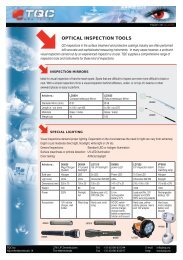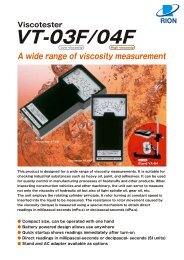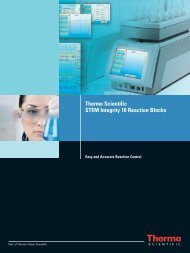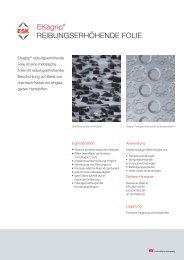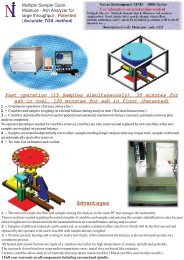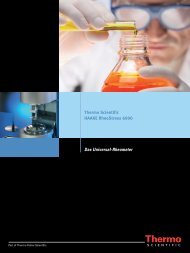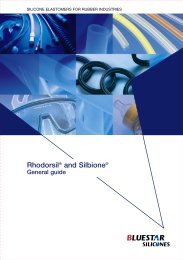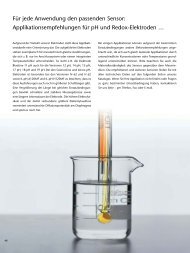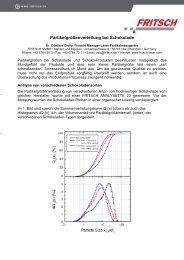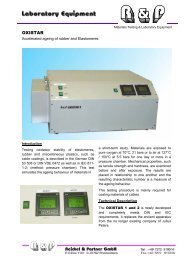Temperature Control Solutions - Labo Plus
Temperature Control Solutions - Labo Plus
Temperature Control Solutions - Labo Plus
Create successful ePaper yourself
Turn your PDF publications into a flip-book with our unique Google optimized e-Paper software.
Naturally, there are other factors — such as heating capability, external temperature tracking, deionized water capability,<br />
etc. — that affect how a chiller is ultimately configured. PolyScience will take all of these into consideration when helping<br />
you select the best chiller for your particular application. Here is a summary of the information you’ll need to know to<br />
ensure that the chiller you select is the best one for your application:<br />
• Desired coolant temperature at the inlet to your equipment or process<br />
• Anticipated heat load, as calculated or specified by the equipment manufacturer<br />
• Cooling fluid flow rate and pressure requirements<br />
• Maximum room (ambient) temperature where the chiller will be located<br />
• Internal heat dissipation, space, and portability needs<br />
• Special requirements, such as remote temperature tracking or piping for deionized water<br />
It is generally recommended that 20% to 50% be added to the calculated heat load to provide a safety factor if the<br />
chiller will be operated at ambient temperatures above 20°C (68°F), at high altitude, or if the heat output of the<br />
device is variable. This will also provide a margin of safety for future cooling needs. That said, resist the temptation to<br />
build more of a safety margin into your chiller than is necessary; an oversized chiller will not cool your equipment any<br />
more effectively but will cost more to purchase and operate.<br />
Suggested Chiller Fluid. The most common and acceptable coolant is a mixture of 50% distilled water and 50%<br />
ethylene glycol (polycool EG-25). This combination will provide the best results for set-point temperatures between<br />
-25°C and +80°C (-13°F and +176°F). Although ethylene glycol is not required for set-point temperatures above<br />
freezing (0°C/+32°F), it is highly recommended as glycol helps lubricate pump seals and fluid temperatures inside the<br />
chiller may be below freezing.<br />
Considerations For Pump Selection<br />
Turbine Pumps – Provide moderate flow and moderate pressures 1 (90-100 psi,<br />
6.2-6.9 bar) which makes them well suited to applications that require higher<br />
pressure or experience a higher system pressure drop, such as long tubing runs<br />
or pumping vertically. A robust design makes turbine pumps very reliable and<br />
forgiving to impurities in the fluid stream. Bronze turbine pumps are standard,<br />
stainless steel pumps are available.<br />
Positive Displacement Pumps – Have performance characteristics similar to<br />
turbine pumps and are suitable for high viscosity fluids, or pumping higher or<br />
further from the cooling product and the application. They produce moderate<br />
flow at high pressure 1 ; up to 100 psi (6.9 bar). Brass positive displacement<br />
pumps are standard, stainless steel positive displacement pumps are available.<br />
Centrifugal Pumps (Magnetic Drive) – Offer higher relative flow rates at lower<br />
pressures and are suitable for applications that are in close proximity to the<br />
chiller or require lower pressure, such as glass condensers. Centrifugal pumps<br />
are very quiet and require little maintenance, but they are more sensitive<br />
to pressure drops. Chillers with this pump option that are attached to a device<br />
with a solenoid valve coolant shut-off, require the external bypass accessory.<br />
1 Recirculating Chillers and Heat Exchangers equipped with turbine or positive displacement pumps are supplied with an adjustable pressure<br />
regulator to allow output pressure to be set from 20 psi (1.37 bar) to 100 psi (6.90 bar).<br />
Pressure<br />
Turbine Pump<br />
Positive Displacement Pump Magnetic Drive Centrifugal Pump<br />
Flow<br />
www.polyscience.com | 125




